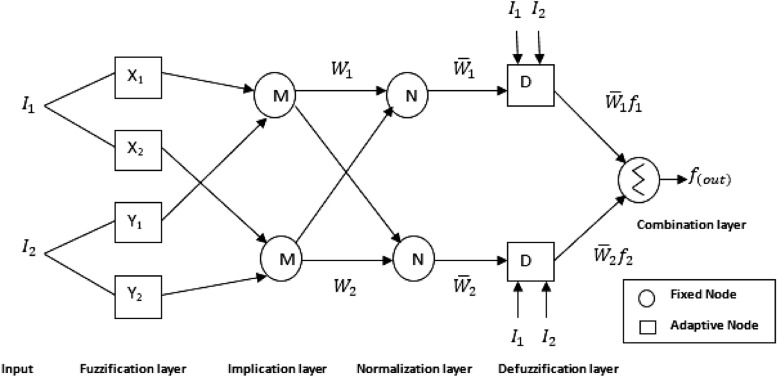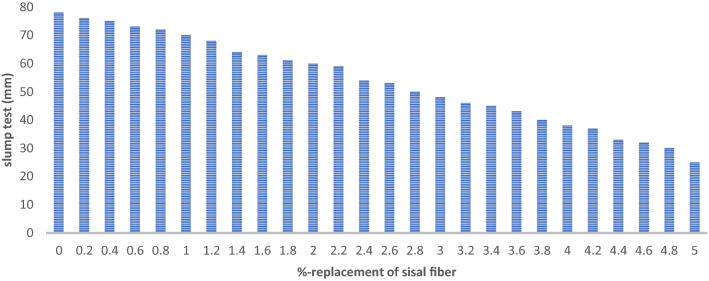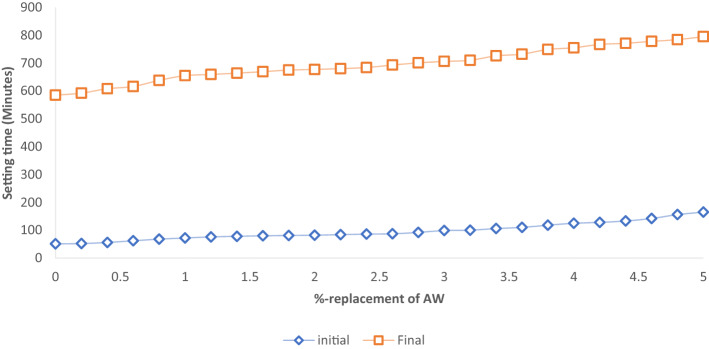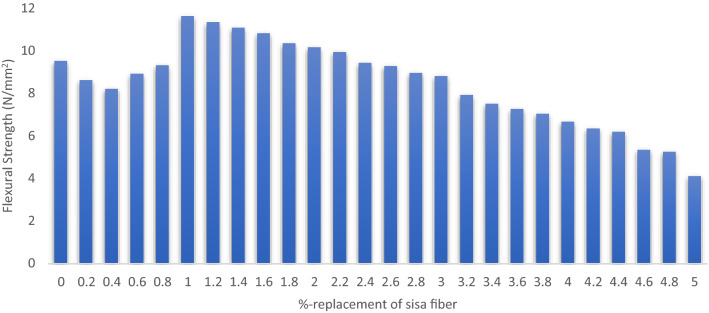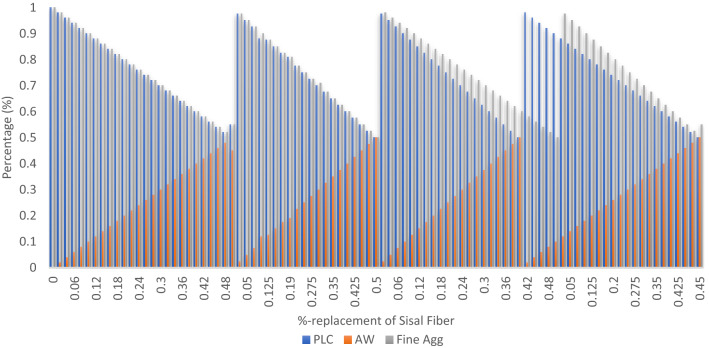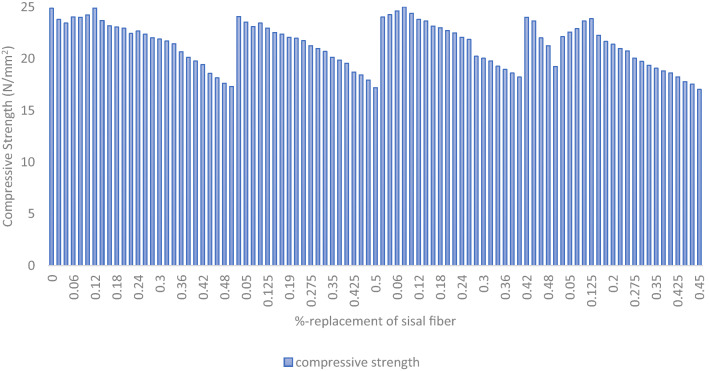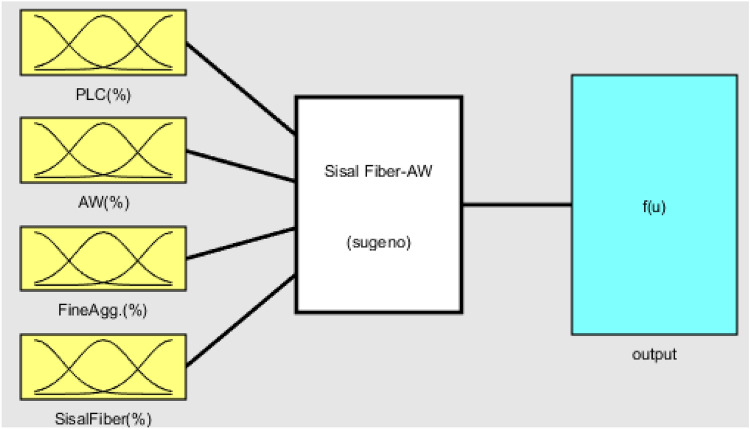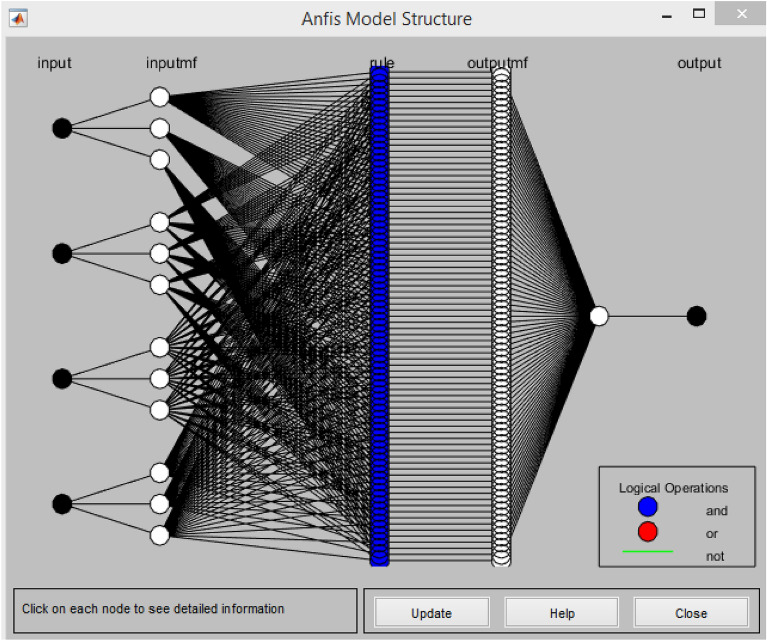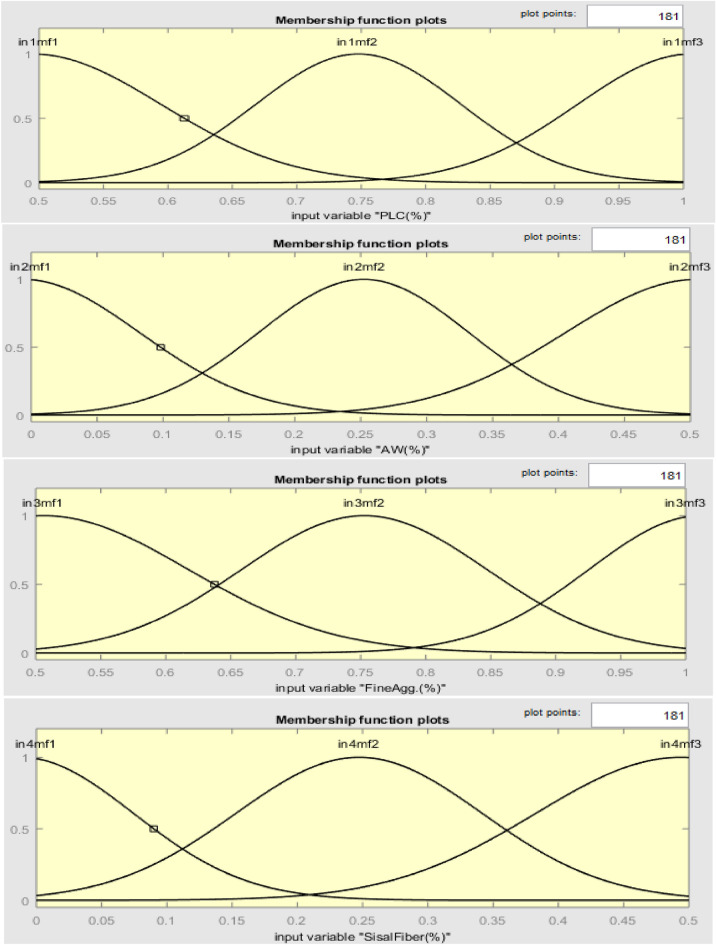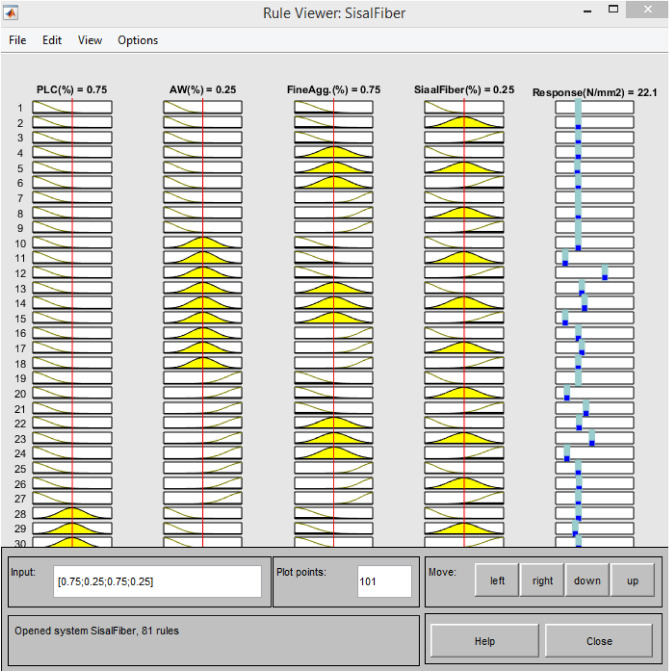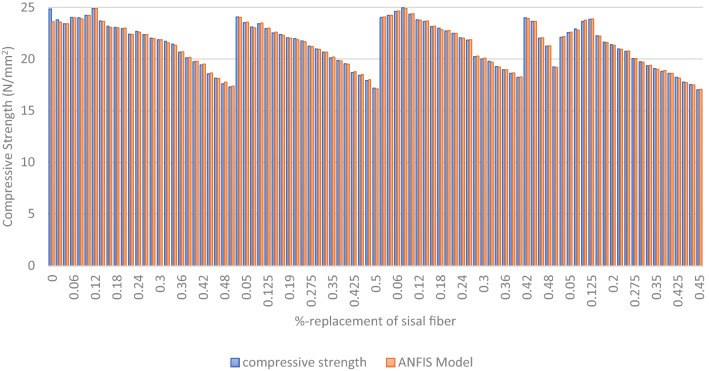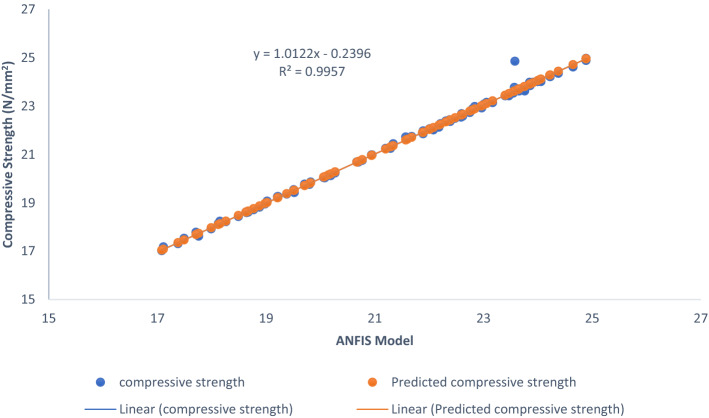Abstract
This research study presents evaluation of aluminum waste-sisal fiber concrete’s mechanical properties using adaptive neuro-fuzzy inference system (ANFIS) to achieve sustainable and eco-efficient engineering works. The deployment of artificial intelligence (AI) tools enables the optimization of building materials combined with admixtures to create durable engineering designs and eliminate the drawbacks encountered in trial-and-error or empirical method. The features of the cement-AW blend's setting time were evaluated in the laboratory and the results revealed that 0–50% of aluminum-waste (AW) inclusion increased both the initial and final setting time from 51–165 min and 585–795 min respectively. The blended concrete mix's flexural strength tests also show that 10% sisal-fiber (SF) substitution results in a maximum flexural strength of 11.6N/mm2, while 50% replacement results in a minimum flexural strength of 4.11N/mm2. Moreover, compressive strength test results show that SF and AW replacements of 0.08% and 0.1%, respectively, resulted in peak outcome of 24.97N/mm2, while replacements of 0.5% and 0.45% resulted in a minimum response of 17.02N/mm2. The ANFIS-model was developed using 91 datasets obtained from the experimental findings on varying replacements of cement and fine-aggregates with AW and SF respectively ranging from 0 to 50%. The ANFIS computation toolbox in MATLAB software was adopted for the model simulation, testing, training and validation of the response function using hybrid method of optimization and grid partition method of FIS at 100 Epochs. The compressive strength behavior is the target response, and the mixture variations of cement-AW and fine aggregates-SF combinations were used as the independent variables. The ANFIS-model performance assessment results obtained using loss function criteria demonstrates MAE of 0.1318, RMSE of 0.412, and coefficient of determination value of 99.57% which indicates a good relationship between the predicted and actual results while multiple linear regression (MLR) model presents a coefficient of determination of 82.46%.
Subject terms: Civil engineering, Structural materials
Introduction
Increase in population, urban growth, and commercialization have been observed to pose a direct impact on rising levels of energy demand and material utilization and, therefore bring about generation of solid wastes1,2. The notion of sustainable development offers one potential remedy for this issue which refers to a course of development that protects natural resources and builds assets in a way that ensures meeting current demands of the people without compromising those of the future generations3,4. One of the few always ever-present concerns is the issue of sustainable and ecofriendly infrastructural development because it is crucial to contemporary society. Given that the current notion is relevant to all types of human activity, the application field for sustainability is almost limitless5,6. The need to determine viable alternatives to the well-known concrete ingredients to achieve sustainability and eco-efficient environment has led to exploitation of solid-waste and the derivatives7. These solid waste materials handling and poor management around the world and more especially in the developing countries have contributed to severe environmental degradation8,9. So, introduction of supplementary-cementitious-materials (SCM) which possesses alumina-silicates contents is helpful towards achieving sustainability and ecofriendly concrete materials through reduction of greenhouse gases emissions10,11.
Utilization or recycling of solid-wastes in production of concrete is also essential towards waste management and involves complex analysis of the factor levels to achieve desired response as regards mechanical and resilience behavior12. By investigating and evaluating the efficacy of additional locally accessible materials that are classified as either industrial or agricultural wastes, some researchers have attempted to reduce the total cost of building materials13,14. Concrete's compressive strength and durability properties are improved by the addition of solid-waste derivatives with alumina-silicate content15. Ayat et al.16 researched on the appropriate ratio of supplementary cementing materials (SCMs), including limestone filler (LF), which was mixed with Portland cement, resulting to environmental, economic and technological advantages. ANN was deployed in the study which were trained using the Tan-sigmoid activation function and the feed-forward back-propagation optimization technique and the results showed strong correlations that exceeded 97%.
Utilization of fibers in concrete helps to improve its post-cracking and ductility characteristics to achieve fiber reinforced concrete. This improved ductility behavior is due to the insertion of fibers that can efficiently transmit tensile stresses throughout a damaged region, hence narrowing the cracks15. Fiber reinforced-concrete is a unique and an important area of research given its significance whereby concrete’s properties such as tensile strength are enriched with fibers which is also devoid of compromise on the compressive strength properties. Concrete under impact force fails extensively as a consequence of its brittle nature16. Therefore, addition of fibers intensifies its many engineering properties such as toughness, flexural strength, impact, resistance to fatigue loads, and thermal shocks. The use of natural fiber reinforced composites is now considered as a new perspective in the construction industry17. Concrete materials possess tough compression characteristics but weak and fragile to resist series of tension forces and hence, there is need to provide support or reinforcement to it. In many instances, steel materials reinforcement was utilized; but a significantly large number of researches are in headway to discover a substitute to steel through the utilization of natural fibers18.
According to earlier studies, sisal-fiber reinforced concrete has improved the concrete's performance, including its workability, strength and durability19. Sisal-fiber has the potential to be employed as admixture and offer good properties especially the compressive, tensile as-well-as flexural-strength, but they are influenced by the fiber-length20. Dhumal et al.21, conducted research to compare conventional concrete and sisal-fiber reinforced-concrete with varying length to assess the influence of the fiber-length in concrete. Volume fraction and aspect ratio are crucial batching criteria used to describe fiber. The aspect ratio (l/d) is the proportion of a fiber's length to its diameter which ranges from 30–150 and plays a crucial part in improving the mechanical behavior of the concrete13,22. Conversely, the volume of fiber in a concrete matrix is known as volume fraction. However, current research suggests that fibers are introduced through weight ratio of cement. According to some studies, the ideal fiber content by cement mass is 1%; any higher additions cause a loss in the concrete's compressive and split tensile strengths, respectively, only for tiny modulus fibers14,23.
Artificial-intelligence (AI) or machine-learning refers to any system that presents features concomitant with a human mind, such as learning and problem-solving. AI copycats’ human intelligence and is used in expert, knowledge-based, and robot systems24. Neural networks are used as appropriate tools of pattern matching and can have their weights automatically adjusted to have the response function optimized, despite their inability to infer how to arrive at certain decisions25. On the other hand, fuzzy logic overcomes this limitation by inferring how to arrive at a certain judgment but is unable to educate itself and learn autonomously. As a consequence, the concurrent use of both techniques might serve as complements with the aim of resolving the many problems that non-hybrid soft computing techniques have26,27. Among these, the Adaptive Neuro-Fuzzy Inference System (ANFIS) is one of the best possible modeling tools, having many applications in several fields of inquiry and study. Jang introduced ANFIS, which provides connections between neural networks and fuzzy logic for modeling complex and dynamic systems28. Its functional set of rules is derived from a combination of the least-squares and back-propagation algorithm that serves as an indicator to adjust the parameters and output of the fuzzy inference system (FIS). The If–then rules are also implemented in the ANFIS data processing mechanism through generating a mapping between the variables of input and output29.
In order to obtain a specified design strength and other desired features, concrete-mix-design comprises the evolution of establishing the quantities of the different elements of concrete. Although the assessment of the mixture-response is often an empirical process based on specific design codes, statistical methodologies and response surface methods have been applied30,31. In recent times, smart intelligent models are now developed for the optimization of the response parameter to obtain the mixture ratio with maximum response at minimum number of trials32,33. Alaneme et al.34 researched on ANFIS optimization of compressive-strength performance of periwinkle shell (PWS) and rice-husk-ash (RHA) concrete. Sixty-two (62) datasets derived in the laboratory outcomes were employed to develop the model. The ANFIS-model performance evaluated through loss-function-parameters presented MSE of 0.3906, RMSE of 0.625, MAE of 0.2244, and coefficient of determination (r2) of 98.67%. Also, Nataraja et al.35, proposed a fuzzy-neuro model for concrete component design. In order to measure out the necessary amounts of fine and coarse aggregates, cement and water for a concrete mix's required mechanical properties, 5-layered FIS and three-layered-ANN were hybridized. It was determined that the model performs adequately when compared to traditional approaches, but provides slightly lower contents than the latter within a tolerable range.
The research study overall idea is to integrate industrial residue such as aluminum waste (AW) with appreciable pozzolanic comportment and agro waste like sisal fiber to partially replace the core concrete components of cement and fine aggregates respectively, from 0–50%. The essence of this exercise is to recycle solid industrial and agro wastes so as to achieve sustainable, eco-efficient and green concrete with enhanced mechanical and durability performance. This experimental investigation is aimed at the deployment of Soft-computing technique (ANFIS) to appraise the mechanical response to facilitate the determination of the optimal combination of the green fiber-reinforced concrete ingredients.
ANFIS
Jang's proposed Adaptive Neuro-fuzzy inference system (ANFIS) provides a realistic procedural environment that combines Neural-Network and Fuzzy-logic philosophies to aid the fuzzy-model research and understanding of details from provided clusters of data36,37. It is a network of directed linkages and nodes that can be learned from and adjusted, and it produces learning rules related to membership function requirements that can be obtained from datasets, ensuring proper statistical inference of data38. ANFIS imitates the neural network's capacity to learn in order to generate appropriate MF and similar if–then rules of fuzzy sets from a given input–output model variables connection. Because it joins in together neural-networks and fuzzy-logic codes, it is capable of capturing the advantages of the two in a one outline. Its interpretation structure matches to a group of fuzzy-IF–THEN rules with adaptability and potential to round-up non-linear tasks39.
Design network architecture of ANFIS
Figure 1 depicts the structural and functional layout of ANFIS, which uses 5-layers to build the smart model with each layer associated with several node functions. Equations 1–2 provide the fuzzy-if–then-rules for Sugeno fuzzy first order as well as the ANFIS-model fuzzy perceptive tool for two inputs . where Ai and Bi are the membership function parameters, while Pi, qi and ri are the learnable parameters of the output variables40,41.
| 1 |
| 2 |
Figure 1.
ANFIS architecture.
The five isolated strata of the ANFIS-framework are explained thus;
Layer 1: The first Fuzzy layer possesses adaptive nodes with node-functions that convert inputs into linguistic labels of fuzzy set in order to determine data membership values. This stratum is in charge of the input data-fuzzification, in which the crisp data are plotted into attributes ranging from 0 to 1, allowing the degree of relatedness of the constraints to be calculated. Similarly, the membership function values required for each ith node are anticipated as indicated in Eq. (3).42,43.
| 3 |
where is the input variable for the ith node and the linguistic variables associated to the node function and is the derived membership function.
Layer 2: This layer possesses fixed nodes which computes the product of all input signals as the associated firing strength. The outcome of the firing-strength (signal) coming as stated in Eq. (4) is used to get the rule-matching-factor , which is the firing-strength44,45.
| 4 |
Layer 3: normalization of MF parameters is realized in this layer. The regularization is achieved by dividing the layer node’s ith signal computed by the sum total of all signal rules as shown in Eq. (5)38,46.
| 5 |
Layer 4: Sugeno first order polynomial was applied in the layer to obtain relationship among the input–output parameter. The node function is adjustable as described in Eqs. (6, 7).
| 6 |
| 7 |
where f1 and f2 are the if–then fuzzy results presented in Eqs. (1, 2), where (, and ) are set of adaptive parameters referred to as the consequent variables47,48.
Layer 5: This layer, often referred to as the defuzzification layer, is made up of a single solitary node that creates the total of all signals that are received by succeeding nodes, with the end result typically being a single value as shown in Eq. (8)43,49.
| 5 |
Method and materials
Materials
Portland cement
In this investigation, Dangote cement (42.5 grade) with a 30-percent normal consistency that complied with CEM II standards as stated in Nigerian Industrial Standard (NIS) 444–1 requirements, proportions, and compliance indicators was employed50.
Water
Water is a crucial component that has an impact on the rheological and mechanical characteristics of concrete. For this investigation, clean, drinkable water was used, and it complies with ASTM C1602-12 specifications for water to be used in concrete mixtures51.
Sisal fiber
Locally available sisal fiber from Akwa Ibom state were processed manually and used for the experimental investigation. Sisal fiber was chopped into 20-25 mm pieces and used for the investigation. Using a Hounsfield tensometer, the sisal fiber's tensile strength was measured. To guarantee durability, the fibers were given a silica fume treatment by being submerged in a slurry before being added to the concrete and given 13 min to dry.
Aluminum waste
The Aluminum waste was obtained from Aluminum Extrusion Industry (ALEX), Inyishi in Ikeduru L.G.A., Imo State, Nigeria. It is produced by heating aluminum scraps at a temperature of 1980 °C in a furnace. The waste is then sieved through a 150 μm sieve size so as to obtain the particles of waste in a finely divided state in accordance with ASTM C618–78 specification52.
Fine and coarse aggregates
The studies utilized sand taken from a clean river bed in Cross River State, Nigeria as the fine aggregates. It was made in accordance with BS EN 12,620 requirements and sieved via a 2.36 mm standard size53. The experimental investigation also employed clean, well-graded crushed granite with a maximum particle size of 20 mm that was procured from Abia State for the coarse aggregates, and it likewise adhered to ASTM C125-1654.
Methods
Compressive strength test
A conventional batching concrete mix of 1:1.5:3 and a w/c of 0.55 were the mixture design used, which included the replacement of fine aggregate and cement in the green fiber concrete mixture with sisal fiber and aluminum waste from 0 to 50%. The concrete mixture materials were then completely mixed with water to achieve a homogeneous mixture before placement and compaction in the 150 mm × 150 mm × 150 mm cubic mould dimensions. After 24 h, the concrete samples were placed in a curing tank at room temperature for 28 days. Before crushing, it is weighed to assess its compressive strength, which is computed using Eq. (9)55,56.
| 9 |
Flexural strength test
Concrete beam moulds measuring 100 mm by 100 mm by 400 mm were used to test flexural strength. The concrete beams were cast and hydrated at 28 days with mixing proportion of 1:1.5:3 and water-cement fraction of 0.55 for the mixture design comprising replacement of cement and fine aggregate in the green fiber concrete mixture with sisal fiber and Aluminium waste correspondingly from 0–50%. Three specimens were cast and cured after 28 days. After 28 days of curing, the three specimens for each combination were crushed and the average flexural strength was measured using Eq. (10) in accordance with ASTM C1161-02c(2008)e157.
| 10 |
Setting time test
The Vicat apparatus is used to achieve the final and initial setting of the freshly blended mixture paste in compliance with CEN-EN 196-3 specifications58. During the experiment, 400 g of cement-Aluminum varying fractions were mixed with 0.85P of water to form a paste blend where P represents the paste normal consistency. Once the vicat mold is filled with the plastic mixture, it is gently set on the vicat equipment. The initial setting pin is fitted to the vicat apparatus to calculate the initial setting time before the vicat mold with the mixed paste is placed on it. The vicat apparatus's calibration mark is pasted to a ± 5 mm distance in millimeters, and the starting pin is dropped there to determine the setup time. After that, the amount of time that passed between the addition of water to the cement and the period in minutes the pin was dropped is noted, leaving a mark on the apparatus of ± 5 mm, indicating the first setting time. Immediately after the first setting time reading is acquired, the apparatus is connected, and this pin is used to determine the final setting time. The inner pin was allowed to descend freely, and the final setting time was recorded when it left no marks on the paste. When the inner final setting pin leaves a mark on the paste, the final setting time is then recorded, beginning when the cement was first mixed with water59.
Flowchart of the ANFIS modelling algorithm
Following the extraction of experimental findings from the laboratory, the mixed design data and the accompanying answers created were logically sorted to provide the needed variables for model construction. The datasets are separated into two pieces of 30% and 70% for testing and training the model, accordingly. Following training, the smart model generated learns to generalize the experimental data that it has been given in order to make correct predictions. Figure 2 depicts the methodology's algorithm flowchart. providing the sequence of events or activities for the research study that begins with the definition of study goals and targets, experimental activity, and data base sorting that allows for the creation of model variables used in the ANFIS modelling process These include training, validation, and testing using productivity assessment criteria such as Root mean square error (RMSE), mean square error (MSE), and coefficient-of-determination (R2)37,60.
Figure 2.
Research study flowchart.
Evaluation of model performance
The effectiveness of the generated model was evaluated in order to confirm that it has a shown capacity for forecasting the target variables with a respectable level of accuracy. Based on relevant research, a number of performance requirements are derived from statistical measurements like R-values and less important function characteristics like MAE and RMSE using the equations in Eqs. (11) and (12).
| 11 |
| 12 |
where n represents the number of data points in the study, is the actual or experimental results while is the model estimated values61.
Results discussion and analysis
Test materials characterization
Tables 1, 2 demonstrate the physical and chemical characteristics of the cement and admixtures (sisal fiber and aluminum scrap) used in this experimental study. The derived physicochemical characteristics indicate that AW possesses SiO2 (54.79%), Al2O3 (15.89%) and Fe2O3 (0.26%) producing a sum of 70.94% which revealed decent pozzolanic characteristics in agreement with ASTM C618, 98 requirements24,52. The abundance of CaO, Al2O3 and Fe2O3 at 11.3%, 20.6% and 6.405% respectively in the Portland limestone cement (PLC) component makes sure that the cement is fully hydrated, which enhances the concrete's mechanical strength behavior. The hydration compounds that are created when and aluminates silicon oxide from the admixture react with calcium to produce hard material over time. The results on the physicochemical behavior of test sisal fiber indicates aspect ratio, tensile strength, diameter and density of 250, 352Mpa, 1.1 mm and 1.6 g/cm3 respectively62. The chemical composition of the fiber showed 70% cellulose, 11% hemi-cellulose, 8% Lignin and 9% Pectin. The results of these tests on the compositions of admixtures are consistent with those of Bharath and Srikanth20.
Table 1.
Physicochemical properties of cement and aluminum waste (source 24:).
| Elemental oxide | AW (%) | PLC (%) |
|---|---|---|
| CaO | 18.02 | 11.3 |
| MgO | 0.51 | 0.093 |
| Fe2O3 | 0.27 | 6.405 |
| Na2O | 0.38 | 2.1 |
| Al2O3 | 15.86 | 20.6 |
| SiO2 | 54.78 | 52.4 |
| ZnO | 0.77 | Trace |
| MnO | 0.58 | Trace |
| LOI | 6.2 | 3.9 |
| SO4 | Nil | Trace |
| CdO | Trace | Trace |
| TiO2 | Trace | 0.52 |
| CUO | Trace | Trace |
| K2O | Nil | 2.6 |
| Specific gravity | 3.39 | 3.12 |
| pH | 8.2 | 8.8 |
| Moisture content | 0.28 | 2.4 |
Table 2.
Physicochemical properties of sisal fiber (source 20:).
| Properties | Results |
|---|---|
| Tensile strength (Mpa) | 352 |
| Elongation (%) | 2.75 |
| Diameter (mm) | 1.1 |
| Density (g/cm3) | 1.6 |
| Young’s modulus (Gpa) | 18 |
| Moisture content (%) | 6.55 |
| Aspect ratio | 250 |
| Specific gravity | 0.73 |
| Water absorption (%) | 43.58 |
| Chemical properties | % Present |
|---|---|
| Cellulose | 70 |
| Hemi-cellulose | 11 |
| Lignin | 8 |
| Ash | Nil |
| Pectin | 9 |
| Wax | 2 |
A semi-log plot that displays the gradation and distribution of the aggregate components employed in the experimental inquiry is created from the sieve analysis of the test materials. From the data provided in Fig. 3, it can be seen that for the coarse and fine aggregate, correspondingly, 75.3–12.3% and 93.4–0.13% pass through sieve sizes of 10-2 mm and 2 mm-75 m. In the case of aluminum waste (AW), 100–54.68% of the material passes through filter sizes of 2 mm–75 µm. In addition, Table 3 presents the coefficients of gradation computation, which were derived using Eqs. (13) and (14). The findings achieved meet the BS 882 standards for increased concrete durability performance63,64.
| 13 |
| 14 |
Figure 3.
AW, fine and coarse aggregates sieve analysis.
Table 3.
Gradation coefficients.
| Test materials | D10 | D30 | D60 | Cu | Cc |
|---|---|---|---|---|---|
| AW | 0.054 | 0.065 | 0.105 | 1.94 | 0.75 |
| Fine Agg | 0.14 | 0.22 | 0.5 | 3.57 | 0.70 |
| Coarse Agg | 1.85 | 3 | 5.1 | 2.76 | 0.954 |
Rheological properties results
Slump test results
Workability test result (Slump) which assesses the workability property of the concrete matrix indicates that value of the slump test reduces with increase in the AW content in the concrete mixture by requiring more water in order to make the mixture more workable in consonance with BS EN 12,350–2 specifications65. The high requirement of water is as a result of the presence of silica and increased surface area for the ash sample. This is because of silica-lime reaction require more water in addition to the water presented for the cement hydration reaction process. The obtained result is presented in Fig. 4 for the concrete samples replaced by 0–50% of sisal fiber and aluminum waste respectively66.
Figure 4.
Slump test results.
Setting time results
From the obtained results, it was perceived that the incorporation of AW effected the increase of the initial setting time from 51 to 165 min, while that of final setting time also rose from 585 to 795 min from 0–50% respectively. This is due to the fact that the inclusion of AW decreases the cement paste's surface area, which slows the hydration process and lengthens setting time. The low rate of heat generation results from the delayed hydration. This is crucial for mass concrete production since it calls for less hydration heat. The graph of cement/AW paste setting time versus %-replacement is presented in Fig. 5. As a consequence, the cement-AW paste's initial and ultimate setting times are longer as the AW concentration increases67.
Figure 5.
Setting time versus %-replacement of AW.
Mechanical strength response
The laboratory tests carried out to derive the mechanical behaviour of the blended concrete mixes were done on the hardened samples after 28 days hydration period. The compressive and flexural strength responses were calculated to determine the mixture combinations with maximum and minimum strength characteristics68.
Flexural strength
The experimental methodology for the flexural strength tests is four point loading configuration flexural test according to ASTM C1161-02c(2008)e1 specification as shown in Fig. 657. the cured blended green concrete beams of 100 mm × 100 mm × 400 mm with varying combinations of AW-sisal fiber mixtures were tested and the test results is presented in graphical chart in Fig. 7. Laboratory results indicated maximum flexural strength of 11.6 N/mm2 for 10% sisal fiber replacement while the minimum flexural strength of 4.11 N/mm2 was derived for 50% replacement. The calculated results showed that the addition of sisal fiber is effective at 0–10% replacement, however, from 20–50% replacement the strength properties tend to decrease linearly. This strength increment is due to the bonding and fiber integration in the concrete matrix which is also consistent with the findings of Alaneme and Mbadike10.
Figure 6.
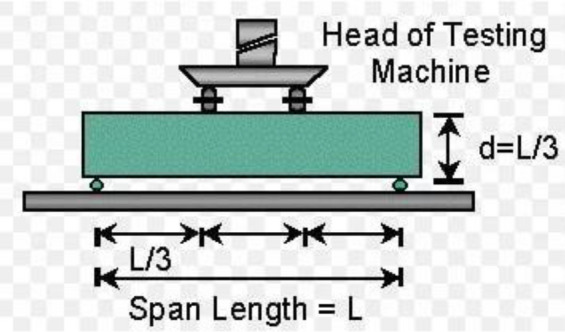
Loading configuration: four-point load flexural test (ASTM C78).
Figure 7.
Flexural strength response.
Test admixtures and compressive strength response interaction
The graphical interaction of the test admixture of sisal fiber and aluminium waste in respect to the concrete’s compressive strength response computed using Eq. (1) were presented in Fig. 8. The graph that is shown demonstrates how the optimal mechanical strength output was affected by the different AW and fiber quantities in the concrete mixture. The graphic 3-D surface plot shows that the highest compressive strength response was 24.97 N/mm2 when sisal fiber and AW were replaced at 0.08% and 0.1%, respectively. The lowest response was 17.02 N/mm2 when sisal fiber and AW were replaced at 0.5% and 0.45%, respectively. The experimental results obtained and the generated admixture ingredients’ fractions were taken to develop smart intelligent model using hybrid neuro-fuzzy inference system to evaluate the effects of these admixtures on the concretes strength performance. The computed experimental findings showed that the prepared green concrete performed more mechanically and was also within NCP 169 and BS 8110: Part 170 standards.
Figure 8.

Concrete admixtures versus response.
Experimental responses and system database for the ANFIS model evaluation
Information derived from experimental findings, professional judgment, and pertinent literature that evaluates the mechanical-strength characteristics of created green fiber reinforced concrete. The model's input variables are blended mixtures of cement-AW and fine aggregates-sisal fiber combinations ranging from 0 to 50%, and its output variables are the concrete's mechanical strength qualities after curing for 28 days as seen in Figs. 9 and 1071. Table 4 displays the statistical findings of the output-input variables' correlation analysis, which highlights the linear interdependence between the parameters. The results indicates positive correlation coefficient for the PLC and fine aggregates fractions at 0.906 and 0.846 respectively with respect to the response variable. However, negative correlation coefficient score was calculated for the AW and sisal fiber fraction at − 0.906 and − 0.846 respectively. More so, Table 5 describes the data sets’ statistical characteristics and features in terms of its distribution, central tendency and variability72.
Figure 9.
Input data.
Figure 10.
Output data.
Table 4.
Correlation statistical results of ANFIS model variables.
| Variables | PLC | AW | Fine Agg | Sisal fiber | Targets |
|---|---|---|---|---|---|
| PLC | 1 | ||||
| AW | − 1 | 1 | |||
| Fine Agg | 0.754115 | − 0.75412 | 1 | ||
| Sisal fiber | − 0.75412 | 0.754115 | − 1 | 1 | |
| Compressive Str | 0.905739 | − 0.90574 | 0.845769 | − 0.84577 | 1 |
Table 5.
Statistical parameters of system datasets for the model development.
| Variables | Mean | SE | SD | SV | Kurtosis | Skewness | Min | Max | Count |
|---|---|---|---|---|---|---|---|---|---|
| PLC | 0.7421 | 0.0153 | 0.1458 | 0.0212 | − 1.2068 | 0.0164 | 0.5 | 1 | 91 |
| AW | 0.2578 | 0.0153 | 0.1458 | 0.0212 | − 1.2068 | − 0.0164 | 0 | 0.5 | 91 |
| Fine Agg | 0.743 | 0.0152 | 0.1451 | 0.0211 | − 1.2231 | 0.0295 | 0 | 0.5 | 91 |
| Sisal Fiber | 0.2569 | 0.0152 | 0.1451 | 0.0211 | − 1.2231 | − 0.0295 | 0 | 0.5 | 91 |
| Compressive Str | 21.4155 | 0.2288 | 2.1827 | 4.7640 | − 1.0550 | − 0.3200 | 17.02 | 24.97 | 91 |
SE standard error; SD standard deviation; SV sample variance.
Smart intelligent model formulation
To properly develop the ANFIS model output-input variables, data from related published articles, experimental findings, and expert judgment were employed. Figure 11 displays the model variables' interaction demonstrating the input–output link. The mechanical behavior of green concrete generated with various ratios of AW and sisal fiber as admixtures was model-simulated, tested, trained, and validated using the ANFIS computation toolkit in MATLAB software. The system datasets were imported from the workspace and generated utilizing the Grid Partition Method of the Fuzzy Inference System (FIS), which would improve the accuracy of the data generalization73. Furthermore, the learning algorithm used uses a hybrid optimization technique that was put to use during the 100-epoch training of the fuzzy inference system (FIS). The processing settings are shown in Table 6, which includes the learning and membership function parameters for the data processing with zero error margin, 0.5 for range of influence, squash factor, reject, and accept ratios of 1.25, 0.15, and 0.5, respectively. This clever intelligent model building, as shown in Eq. (15), used the Gaussian membership function (gaussmf)29.
| 15 |
where and represents is the standard deviation and mean for the Gaussian function.
Figure 11.
Connectivity of the ANFIS model parameters.
Table 6.
ANFIS network processing parameter.
| ANFIS network parameter | Settings |
|---|---|
| Fuzzy inference system type | Grid partition |
| Number of membership functions | 3 |
| Fuzzy rules numbers | 81 |
| Types of membership functions | gausianmf |
| Or method | Probor |
| Error margin | 0 |
| And method | Prod |
| Implication method | Minimum |
| Epochs | 100 |
| Aggregation | Maximum |
| Method of optimization | Hybrid |
| Defuzzification | Wtaver |
Testing and training ANFIS
Using the recommended hybrid optimization training techniques and FIS variables, ninety-one (91) datasets that are employed for the modelling process are split and sorted into 2 parts to accomplish the network's training (60) and testing (31), respectively. Figure 12 displays the datasets imported from the workspace for the ANFIS network training, which contain one output and four input variables. It also displays the graphic plot of the 60 index for the network training. After 28 days of curing, the ANFIS network was trained using the loaded datasets to accurately generalize the data and assess the compressive strength properties of the AW-sisal fiber concrete. For this operation, the hybrid training approach was used with settings for 100 Epochs, 0% tolerance, and grid partitions. After the training procedure, a training error result of 0.365 was produced, indicating improved performance as shown in Fig. 13. As shown in Fig. 14, after the ANFIS network training using the sorted experimental data is complete, the 60 data points that were previously empty and blue are highlighted with red asterisks to show accomplishment of the training stage. The average testing error was 0.364874.
Figure 12.
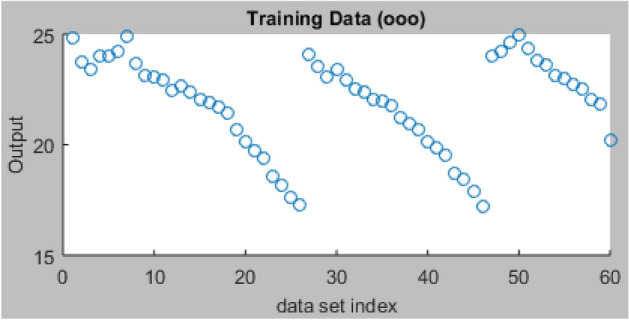
ANFIS model training graphical plot.
Figure 13.
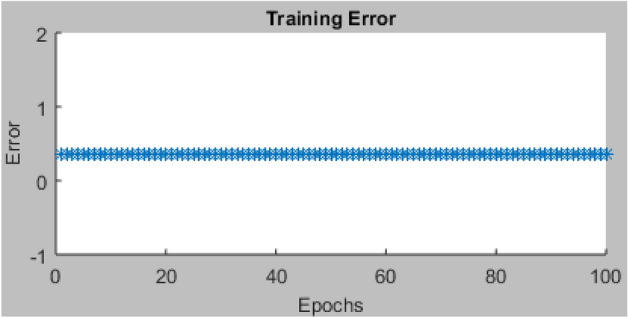
ANFIS training error plot.
Figure 14.
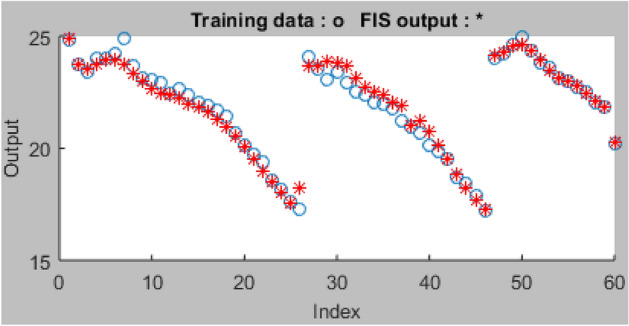
Training data plots.
Following the completion of training, the 31 datasets reserved for testing the trained model are further imported from the MATLAB program workspace to guarantee improved predictive accuracy. As illustrated in Fig. 15, the loaded testing datasets and the trained ANFIS network datasets were displayed together. The loaded testing datasets were colored blue with 31 index points.
Figure 15.
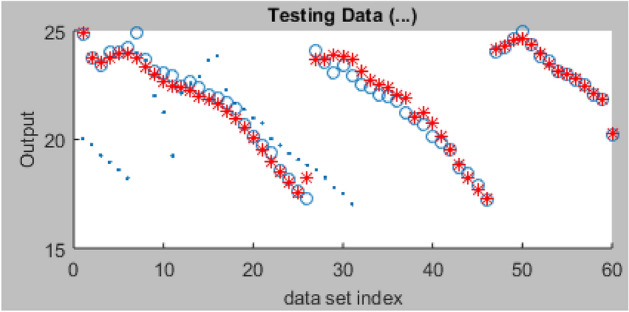
Plot of ANFIS training and testing data sets.
In order to assure a better outcome in terms of predictive performance, the network testing was conducted using the processing parameters originally set out for the ANFIS model training. Using the set-out datasets, a testing error of 2.663 was computed after the testing, as shown in Fig. 16.
Figure 16.

Plot of ANFIS testing datasets.
Constructed network architecture of ANFIS
Figure 17 as generated from the MATLAB R2020a software depicts the ANFIS architecture produced after training and testing using the datasets provided to the network. The intricate interaction between the input variables, the fuzzification node, the input signal weight aggregation, normalization of the network's firing intensity, fuzzy if–then rule creation, and total cumulative function for the output nodes are shown. The design combines four input parameters, PLC (%), AW (%), fine aggregates (%), and sisal fiber (%), with one output for the compressive strength response of the concrete75.
Figure 17.
ANFIS model structure generated from MATLAB R2020a.
ANFIS network membership function plots
The membership functions (MF) plots for the model input variables for the developed ANFIS network is generated automatically after the training and testing processes as shown in Fig. 18. The plot indicates data range for input parameters on the x-axis against the universe of discourse which possess values ranging from 0 to 1 on the y-axis76.
Figure 18.
Membership function plots of model variables.
ANFIS-model variables graphical expression
The ANFIS model, which was used to evaluate the compressive strength qualities of concrete made with AW-sisal fiber, uses a hybrid learning strategy to learn how to generalize the data sets that are provided to it. A given input space may be correctly mapped by the created smart model to the appropriate output response. The connections between the model variables are assessed to determine their individual significant relevance or impacts, as illustrated in Figs. 19, 20, using a three-dimensional surface plot and simulation rule viewer. The plots show that addition of sisal fiber and aluminum waste in the matrix to substitute fine aggregates and cement from 0–45% and 0–25% respectively resulted to enhancement in the compressive properties of the green concrete produced. After data sets have been made more generic by training and testing, the rule viewer will make it possible to derive simulated ANFIS model outputs. To determine the ideal ratios of the concrete mixture to accomplish sustainable building, the impacts of sisal fiber and aluminum waste integration in concrete were evaluated77.
Figure 19.
Model variables’ 3D-surface plots.
Figure 20.
Rule viewer generated from MATLAB R2020a.
Model validation
The ANFIS approach was used in the modeling process to optimize the experimental findings acquired to assess the compressive strength characteristics of AW-sisal fiber concrete, and the model result is shown in a graphical chart shown in Fig. 2178. Additionally, using Minitab 18 statistical software, the generated ANFIS model's performance in terms of prediction accuracy was evaluated by statistically comparing the real or experimental findings with those of the ANFIS model. MLR statistics, RMSE, MAE, and coefficient of determination were used in this comparison. In Table 7 and Fig. 22, the MLR findings and residual graphs are shown. The R-sq. (adj.) and R-sq. values of 88.16% and 88.69%, respectively, indicated that the compared datasets had an average degree of correlation based on the results of the MLR calculation61,79.
Figure 21.
Experimental and ANFIS model results.
Table 7.
Multiple linear regression statistical results.
| Model summary | Regression coefficients | ||||||
|---|---|---|---|---|---|---|---|
| S | R-sq. (adj.) | R-sq | Constant | PLC | AW | Fine Agg | Sisal fiber |
| 0.751 | 88.16% | 88.69% | 59.0 | − 10,121 | − 10,131 | 10,088 | 10,082 |
Figure 22.
Residual plots for the target response using MLR.
According to the derived statistical findings, which are represented in Table 8 by MAE, RMSE, and coefficient of determination values of 0.1318, 0.412, and 99.57%, correspondingly, there is no appreciable discrepancy between the experimental or real data and the results of the ANFIS model. The result suggests that the created ANFIS model performed better than the linear regression model as well. The model's quantitative assessment results concurred with the conclusions of Alaneme et al.34 and Wang et al.80.
Table 8.
Performance evaluation of ANFIS model.
| Target output | Statistical parameter | Requirements | Calculated results | Remarks |
|---|---|---|---|---|
| Compressive strength | MAE | Close to 0 | 0.1318 | Excellent |
| RMSE | Close to 0 | 0.412 | Very good | |
| R2 | Greater than 0.8 | 0.9957 | Very good |
Figure 23 displays the slope of the regression line comparing laboratory or real findings to the outcomes of the ANFIS model. The line of best fit, which is the straight line that accurately predicts the given sets of data, is shown in the figure. In Eqns. 16 is given the line-of-fit equation for the compressive strength response of the AW-sisal fiber concrete.
| 16 |
Figure 23.
ANFIS model line of fitness plot.
Conclusions
For the modeling of the mechanical strength properties of concrete with fine particles and cementitious fraction partially replaced by aluminum waste and sisal fiber, correspondingly, from 0 to 50%, adaptive neuro-fuzzy inference system (ANFIS) was used. The research study's findings allow for the following deductions:
The concrete ingredients passed testing for the essential chemical and physical characteristics for excellent pozzolanic performance. The findings of the particle size distribution highlighted the necessity for strong gradation features to create concrete with enhanced durability properties. Following a 28-day hydration interval, concrete's compressive strength findings were also obtained. The computed experimental findings show that sisal fiber and AW were replaced to a maximum compressive value of 24.97 N/mm2 at 0.08% and 0.1%, respectively, and to a minimum compressive value of 17.02 N/mm2 at 0.5% and 0.45%, respectively.
The flexural strength test response of the fiber concrete indicated maximum strength of 11.6 N/mm2 for 10% sisal fiber replacement while the strength reduces with increase content of sisal fiber in the concrete matrix with minimum flexural strength of 4.11 N/mm2 derived for 50% replacement.
The slump results showed that value of the slump test reduces with increase in the AW content in the concrete mixture by requiring more water in order to make the mixture more workable. The setting time test results on the cement-AW blend showed that the addition of AW effected the increase of the initial setting time from 51 to 165 min, while that of final setting time also rose from 585 to 795 min from 0–50% respectively.
For the creation of the model, the system database was comprised of the sorted information obtained through the experimental approach. The 91 datasets in total were separated into two groups, with the latter group receiving 60 datasets and the former group receiving 31 datasets, respectively, in order to test and train the adaptive network.
Additionally, MLR, MAE, RMSE, and r2 were used to evaluate the generated ANFIS model's ability to predict outcomes. The findings of the statistical analysis show an MAE of 0.1318, RMSE of 0.412, and R2 of 99.57%, while the MLR model shows a coefficient-of-determination of 88.69%. Incorporating the industrial waste residues under investigation in this study offers a viable alternative to the traditional concrete ingredients for the production of green concrete that reduces the amount of carbon dioxide released during the manufacture and use of cement, the cost of infrastructural construction materials, the disposal of industrial waste without regard for its intended use, and other factors that contribute to sustainability and the environment.
Furthermore, smart-intelligent model development was used to assess the created mechanical strength results of concrete reinforced with AW-sisal fiber. This was accomplished via the use of ANFIS soft computing. The findings of this research demonstrate the versatility of the ANFIS approach with relation to its use in modeling the engineering behavior of cement-additive concrete blends for sustainability.
Abbreviations
- ANFIS
Adaptive neuro-fuzzy inference system
- AW
Aluminum waste
- AI
Artificial intelligence
- ANN
Artificial neural networks
- r2
Coefficient of determination
- FIS
Fuzzy inference system
- guassmf
Gaussian membership function
- MF
Membership function
- MLR
Multiple linear regression
- probor
Probabilistic OR
- RMSE
Root mean squared error
- MAE
Mean absolute error
- MSE
Mean squared error
- SCM
Supplementary cementitious materials
- SF
Sisal fiber
Author contributions
CA-conceptualization, write original draft, investigation, methodology EM-project administration, resources, supervision, review of original draft, validation AG-edit original draft, software, data curation, formal analysis, validation, methodology.
Data availability
All data generated or analyzed during this study are included in this published article.
Competing interests
The authors declare no competing interests.
Footnotes
Publisher's note
Springer Nature remains neutral with regard to jurisdictional claims in published maps and institutional affiliations.
References
- 1.Elinwa AU, Mahmood YA. Ash from Timber Waste as cement replacement material. Cem. Concr. Compos. 2002;124(2):219–222. doi: 10.1016/S0958-9465(01)00039-7. [DOI] [Google Scholar]
- 2.Neville, A .M. Properties of Concrete, Pearson Education Limited, Edinburgh (2011).
- 3.Regina C, Stephany S, Henrique B, Ferreira M, Fonseca S, Souza Oliveira CA, Teixeira R, Araújo Gouveia LL. Comparative study about mechanical properties of strutural standard concrete and concrete with addition of vegetable fibers. Mater. Res. 2017;20:102–107. doi: 10.1590/1980-5373-mr-2016-0905. [DOI] [Google Scholar]
- 4.Uwadiegwu AG, Michael ME. Characterization of Bambara nut shell ash (BNSA) in concrete production. Jurnal Kejuruteraan. 2021;33(3):621–634. doi: 10.17576/jkukm-2021-33(3)-21. [DOI] [Google Scholar]
- 5.Elinwa, A. U., & Mamuda, A. M. Sawdust ash as powder material for self-compacting concrete containing naphthalene sulfonate. Adv. Civ. Eng. (2014).
- 6.Sata V, Jaturapitakkul C, Kiattikomol K. Infuence of pozzolan from various by-product materials on mechanical properties of high-strength concrete. Constr. Build. Mater. 2007;21(7):1589–1598. doi: 10.1016/j.conbuildmat.2005.09.011. [DOI] [Google Scholar]
- 7.Chimmaobi O, Mbadike EM, Alaneme GU. Experimental investigation of cassava peel ash in the production of concrete and mortar. Umudike J. Eng. Technol. 2020;6(2):10–21. [Google Scholar]
- 8.Joshua O. Development of a fully pozzolanic binder for sustainable construction: Whole cement replacement in concrete applications. Int. J. Civ. Eng. Technol. 2018;9:1–12. [Google Scholar]
- 9.Onyelowe, K., Salahudeen, A. B., Eberemu, A., Ezugwu, C., Amhadi, T., Alaneme, G. & Sosa, F. Utilization of solid waste derivative materials in soft soils re-engineering. In: Ameen H et al. (ed) GeoMEast 2019. SUCI. Springer, Switzerland AG, pp. 49–57 (2020). 10.1007/978-3-030-34199-2_3
- 10.Alaneme George U, Mbadike Elvis M. optimization of flexural strength of palm nut fibre concrete using Scheffe’s theory. Mater. Sci. Energy Technol. 2019;2(2019):272–287. doi: 10.1016/j.mset.2019.01.006. [DOI] [Google Scholar]
- 11.Onyelowe, K., Salahudeen, A. B., Eberemu, A., Ezugwu, C., Amhadi, T. & Alaneme, G. Oxides of carbon entrapment for environmental friendly geomaterials ash derivation’, Springer Nature Switzerland AG 2020 H. Ameen et al. (Eds.): GeoMEast 2019, SUCI, pp. 58–67 (2020). 10.1007/978-3-030-34199-2_4
- 12.Thomas BS. Green concrete partially comprised of rice husk ash as a supplementary cementitious material—A comprehensive review. Renew. Sustain. Energy Rev. 2018;82:3913–3923. doi: 10.1016/j.rser.2017.10.081. [DOI] [Google Scholar]
- 13.Rai A, Joshi YP. Applications and properties of fibre reinforced concrete. Int. J. Eng. Res. Appl. 2014;4:123–131. [Google Scholar]
- 14.Balasubramanian M, Senthilselvan S, Sabarish KV. Experimental investigation on strength and durability properties of sisal fiber reinforced concrete. Int. J. Chem. Sci. 2016;14:241–246. [Google Scholar]
- 15.Behfarnia K, Khademi F. A comprehensive study on the concrete compressive strength estimation using artificial neural network and adaptive neuro-fuzzy inference system. Int. J. Optim. Civ. Eng. 2017;7(1):71–80. [Google Scholar]
- 16.Ayat H, Kellouche Y, Ghrici M, Boukhatem B. Compressive strength prediction of limestone filler concrete using artificial neural networks. Adv. Comput. Des. 2018;3(3):289–302. doi: 10.12989/acd.2018.3.3.289. [DOI] [Google Scholar]
- 17.Sof A, Saxena A, Agrawal P, Sharma AR, Sharma K. Strength predictions of saw dust and steel fibers in concrete. Int. J. Innov. Res. Sci. Eng. Technol. 2015;4(12):12473–12477. [Google Scholar]
- 18.Malhotra S, Chand J. Experimental investigation on high strength concrete with the addition of steel fiber. Int. J. Civ. Eng. Technol. 2017;8:1130–1140. [Google Scholar]
- 19.Islam SM, Hussain RR, Morshed MA. Fiber-reinforced concrete incorporating locally available natural fibers in normal-and high-strength concrete and a performance analysis with steel fiber-reinforced composite concrete. J. Compos. Mater. 2012;46(1):111–122. doi: 10.1177/0021998311410492. [DOI] [Google Scholar]
- 20.Bharath P, Srikanth A. Effect of fiber length and percentage of SISAL on strength of concrete. Int. J. Adv. Res. Sci. Eng. Technol. 2017;4(9):4583–4594. [Google Scholar]
- 21.Mukesh, D., Onkar, G., Sumedh, G. & Vaishnavi, B. Comparative study on conventional concrete and sisal fiber reinforced concrete with varying length. Int. J. Eng. Technol. Sci. Res. IJETSR5(5) (2018).
- 22.Dalvi JD, Kalwane UB, Pasnur P. Effect of fibre length and percentage of sisal on strength of concrete. Multidiscip. J. Res. Eng. Technol. 2016;3:923–932. [Google Scholar]
- 23.Chanko, B. & Sunilaa, G. Performance of concrete with PET fibers. Int. J. Eng. Sci. Invetion Res. Dev.3, 725–728 (2017).
- 24.Alaneme George U, Mbadike Elvis M. Modelling of the mechanical properties of concrete with cement ratio partially replaced by aluminium waste and sawdust ash using artificial neural network. M. SN Appl. Sci. 2019;1:1514. doi: 10.1007/s42452-019-1504-2. [DOI] [Google Scholar]
- 25.Naderpour H, Rafiean AH, Fakharian P. Compressive strength prediction of environmentally friendly concrete using artificial neural networks. J. Build. Eng. 2018;16(16):213–219. doi: 10.1016/j.jobe.2018.01.007. [DOI] [Google Scholar]
- 26.Onyelowe KC, Alaneme GU, Onyia ME, Van Bui D, Diomonyeka MU, Nnadi E, Ogbonna C, Odum LO, Aju DE, Abel C, Udousoro IM, Onukwugha E. Comparative modeling of strength properties of hydrated-lime activated rice-husk-ash (HARHA) modified soft soil for pavement construction purposes by artificial neural network (ANN) and fuzzy logic (FL) Jurnal Kejuruteraan. 2021;33(2):365–384. doi: 10.17576/jkukm-2021-33(2)-20. [DOI] [Google Scholar]
- 27.Abraham, A. Adaptation of fuzzy inference system using neural learning. In Granular Computing; Springer Science and Business Media LLC: Berlin, Germany (2005), Volume 181, pp. 53–83.
- 28.Aditya M, Chandranath C, Singh RN. Flood forecasting using ANN, neuro-fuzzy, and neuro-GA models. J. Hydrol. Eng. 2009;14:647–652. doi: 10.1061/(ASCE)HE.1943-5584.0000040. [DOI] [Google Scholar]
- 29.Alaneme GU, Mbadike EM, Attah IC, Udousoro IM. Mechanical behaviour optimization of saw dust ash and quarry dust concrete using adaptive neuro-fuzzy inference system. Innov. Infrastruct. Solut. 2022;7:122. doi: 10.1007/s41062-021-00713-8. [DOI] [Google Scholar]
- 30.Ibe Iro, U., Alaneme, G. U., Milad, A., Olaiya, B. C., Otu, O. N., Isu, E. U. & Amuzie, M. N. Optimization and simulation of saw dust ash concrete using extreme vertex design method. Adv. Mater. Sci. Eng. 2022, Article ID 5082139, 22 pages (2022). 10.1155/2022/5082139
- 31.Ikpa CC, Alaneme GU, Mbadike EM, et al. Evaluation of water quality impact on the compressive strength of concrete. Jurnal Kejuruteraan. 2021;33(3):527–538. [Google Scholar]
- 32.Alaneme GU, Attah IC, Mbadike EM, Dimonyeka MU, Usanga IN, Nwankwo HF. Mechanical strength optimization and simulation of cement kiln dust concrete using extreme vertex design method. Nanotechnol. Environ. Eng. 2022;7(4):467–490. doi: 10.1007/s41204-021-00175-4. [DOI] [Google Scholar]
- 33.Sobhani J, Najimi M, Pourkhorshidi AR, Parhizkar T. Prediction of the compressive strength of no-slump concrete: A comparative study of regression, neural network and ANFIS models. Constr. Build. Mater. 2010;24:709–718. doi: 10.1016/j.conbuildmat.2009.10.037. [DOI] [Google Scholar]
- 34.Alaneme GU, Mbadike EM, Iro UI, Udousoro IM, Ifejimalu WC. Adaptive neuro-fuzzy inference system prediction model for the mechanical behavior of rice husk ash and periwinkle shell concrete blend for sustainable construction. Asian J. Civ. Eng. 2021 doi: 10.1007/s42107-021-00357-0. [DOI] [Google Scholar]
- 35.Nataraja MC, Jayaram MA, Ravikumar CN. A fuzzy-neuro model for normal concrete mix design. Eng. Lett. 2006;13(2):98–107. [Google Scholar]
- 36.Jang JSR, Sun CT. Nuro-fuzzy modeling and control. Proc. IEEE. 1995 doi: 10.1109/5.364486. [DOI] [Google Scholar]
- 37.Sadrmomtazi A, Sobhani J, Mirgozar MA. Modeling compressive strength of EPS lightweight concrete using regression, neural network and ANFIS. Constr. Build. Mater. 2013;42:205–216. doi: 10.1016/j.conbuildmat.2013.01.016. [DOI] [Google Scholar]
- 38.Yousef M, Hooshyar D, Remezani A, Sahari KSM, Khaksar W, Alnaimi FBI. Short-term wind speed forecasting by an adaptive network-based fuzzy inference system (ANFIS): An attempt towards an ensemble forecasting method. Int. J. Adv. Intell. Inf. 2015;1(3):140–149. [Google Scholar]
- 39.Rameshkumar A, Arumugam S. A neuro-fuzzy integrated system for nonlinear buck and quasi-resonant buck converter. Eur. J. Sci. Res. 2011;51(1):66–78. [Google Scholar]
- 40.Jang JSR, Sun CT, Mizutani E. Neuro-Fuzzy and Soft Computing, a Computational Approach to Learning and Machine Intelligence. Prentice Hall; 1997. [Google Scholar]
- 41.Samandar A. A model of adaptive neural-based fuzzy inference system (ANFIS) for prediction of friction coefcient in open channel fow. Acad. J. Sci. Res. Essays. 2011;6(5):1020–1027. [Google Scholar]
- 42.Sriraman A, Mayorga RV. A fuzzy inference system approach for greenhouse climate control. Environ. Inf. Arch. 2004;2:699–710. [Google Scholar]
- 43.Cevik A, Ozturk S. Neuro-fuzzy model for shear strength of reinforced concrete beams without web reinforcement. Civ. Eng. Environ. Syst. 2009;26:263–277. doi: 10.1080/10286600802109927. [DOI] [Google Scholar]
- 44.Erdirencelebi D, Yalpir S. Adaptive network fuzzy inference system modeling for the input selection and prediction of anaerobic digestion efuent quality. Appl. Math. Model. 2011;35:3821–3832. doi: 10.1016/j.apm.2011.02.015. [DOI] [Google Scholar]
- 45.AnandaKumar K, Punithavalli M. Efcient cancer classifcation using fast adaptive neuro-fuzzy inference system (FANFIS) based on statistical techniques. Int. J. Adv. Comput. Sci. Appl. 2011;1:132–137. [Google Scholar]
- 46.Topcu IB, Sarıdemir M. Prediction of mechanical properties of recycled aggregate concretes containing silica fume using artifcial neural networks and fuzzy logic. Comput. Mater. Sci. 2008;42(1):74–82. doi: 10.1016/j.commatsci.2007.06.011. [DOI] [Google Scholar]
- 47.Baykasoglu A, Dereli T, Tanis S. Prediction of cement strength using soft computing techniques. Cem. Concr. Res. 2004;34(11):2083–2090. doi: 10.1016/j.cemconres.2004.03.028. [DOI] [Google Scholar]
- 48.Alaneme GU, Onyelowe KC, Onyia ME, Van Bui D, Mbadike EM, Ezugwu CN, Dimonyeka MU, Attah IC, Ogbonna C, Abel C, Ikpa CC, Udousoro IM. Modeling volume change properties of hydrated-lime activated rice husk ash (HARHA) modified soft soil for construction purposes by artificial neural network (ANN) Umudike J. Eng. Technol. 2020;6(1):88–110. doi: 10.33922/j.ujet_v6i1_9. [DOI] [Google Scholar]
- 49.Ujong JA, Mbadike EM, Alaneme GU. Prediction of cost and duration of building construction using artificial neural network. Asian J. Civ. Eng. 2022 doi: 10.1007/s42107-022-00474-4. [DOI] [Google Scholar]
- 50.Nigerian Industrial Standard (NIS) 444-1. Composition, specifications and conformity criteria for common cements. Standard Organization of Nigeria (2003).
- 51.ASTM C1602/C1602M-12 Standard Specification for Mixing Water Used in the Production of Hydraulic Cement Concrete.
- 52.ASTM C 618. 2008. Specification for coal fly ash and raw or calcined natural pozzolanas for use as mineral admixtures in Ordinary Portland Cement Concrete. Annual book of ASTM standards, West Conshecken, USA.
- 53.British Standard (BS) EN 12620 (2002). Aggregates for concrete. British Standard Institution, London.
- 54.ASTM C125-16, Standard Terminology Relating to concrete and concrete Aggregates, ASTM International, West Conshohocken, 2016.
- 55.Alaneme GU, Mbadike EM. Experimental investigation of Bambara nut shell ash in the production of concrete and mortar. Innov. Infrastruct. Solut. 2021;6:66. doi: 10.1007/s41062-020-00445-1. [DOI] [Google Scholar]
- 56.Ezeokpube GC, Alaneme GU, Attah IC, Udousoro IM, Nwogbo D. Experimental investigation of crude oil contaminated soil for sustainable concrete production. Arch. Struct. Constr. 2022 doi: 10.1007/s44150-022-00069-2. [DOI] [Google Scholar]
- 57.ASTM C1161-02c(2008)e1, Standard Test Method for Flexural Strength of Advanced Ceramics at Ambient Temperature, ASTM International, West Conshohocken, PA.
- 58.CEN-EN 196-3 (2016). Methods of testing cement—Part 3: Determination of setting times and soundness.
- 59.Ewa DE, Ukpata JO, Otu ON, et al. Optimization of saw dust ash and quarry dust pervious concrete’s compressive strength using Scheffe’s simplex lattice method. Innov. Infrastruct. Solut. 2023;8:64. doi: 10.1007/s41062-022-01031-3. [DOI] [Google Scholar]
- 60.Obianyo JI, Okey OE, Alaneme GU. Assessment of cost overrun factors in construction projects in Nigeria using fuzzy logic. Innov. Infrastruct. Solut. 2022;7:304. doi: 10.1007/s41062-022-00908-7. [DOI] [Google Scholar]
- 61.Colin CA, Windmeijer FAG. An R-squared measure of goodness of ft for some common nonlinear regression models. J. Econ. 1997;77(2):1790. doi: 10.1016/s03044076(96)01818-0. [DOI] [Google Scholar]
- 62.Attah IC, Etim RK, Alaneme GU, Ekpo DU, Usanga IN. Scheffe’s approach for single additive optimization in selected soils amelioration studies for cleaner environment and sustainable subgrade materials. Clean. Mater. 2022;5:10012. doi: 10.1016/j.clema.2022.100126. [DOI] [Google Scholar]
- 63.Afroughsabet V, Ozbakkaloglu T. Mechanical and durability properties of high-strength concrete containing steel and polypropylene fibers. Constr. Build. Mater. 2015;94:73–82. doi: 10.1016/j.conbuildmat.2015.06.051. [DOI] [Google Scholar]
- 64.Attah IC, Etim RK, Alaneme GU, Bassey OB. Optimization of mechanical properties of rice husk ash concrete using Scheffe’s theory. SN Appl. Sci. 2020;2(5):928. doi: 10.1007/s42452-020-2727-y. [DOI] [Google Scholar]
- 65.BS EN 12350-2 (2019). Slump test for testing fresh concrete.
- 66.Garboczi, E. G., Bentz, D. P. & Frohnsdorff, G. J. The past, present, and future of the computational materials science of concrete. Materials Science Of Concrete Workshop, pp. 27–29, Shelbyville (2000).
- 67.Błaszczyński T, Król M. Usage of green concrete technology in civil engineering. Proc. Eng. 2015;122:296–301. doi: 10.1016/j.proeng.2015.10.039. [DOI] [Google Scholar]
- 68.Ogbonna, C., Mbadike, E. M. & Alaneme, G. U. Effects of cassava-peel-ash on mechanical properties of concrete. Umudike J. Eng. Technol. (UJET) 6(2), 61–75 (2020). 10.33922/j.ujet_v6i2_8
- 69.Nigerian code of practice part 1 (NCP 1) (1973). The structural use of concrete in building. Nigeria Standards Organization. Federal Ministry of Industries, Lagos 28.
- 70.“British standard (BS) 8110 part 1,” Structural Use of concrete, Code of Practice for Design and Construction, British Standard Institution, London, 1997.
- 71.Rencher, A. C., & Christensen, W. F. Chapter 10, Multivariate regression—Section 10.1, Introduction.” In Methods of Multivariate Analysis, Wiley Series in Probability and Statistics, 3rd ed ed., 709 (2012). New York: Wiley. ISBN 9781118391679
- 72.Onyelowe KC, Jalal FE, Onyia ME, Onuoha IC, Alaneme GU. Application of gene expression programming to evaluate strength characteristics of hydrated-lime-activated rice husk ash-treated expansive soil. Appl. Comput. Intell. Soft Comput. 2021 doi: 10.1155/2021/6686347. [DOI] [Google Scholar]
- 73.Nayak PC, Sudheer KP, Rangan DM, Ramasastri KS. Short-term flood forecasting with a neurofuzzy model. Water Resour. Res. 2005;41:41. doi: 10.1029/2004WR003562. [DOI] [Google Scholar]
- 74.Jang JSR. ANFIS: adaptive-network-based fuzzy inference system. IEEE Trans. Syst. Man Cybern. 1993;23(3):665–685. doi: 10.1109/21.256541. [DOI] [Google Scholar]
- 75.Yilmaz I, Yuksek G. Prediction of the strength and elasticity modulus of gypsum using multiple regression, ANN, and ANFIS models. Int. J. Rock Mech. Min. Sci. 2009;46(4):803–810. doi: 10.1016/j.ijrmms.2008.09.002. [DOI] [Google Scholar]
- 76.Alaneme GU, Onyelowe KC, Onyia ME, Van Bui D, Mbadike EM, Dimonyeka MU, Attah IC, Ogbonna C, Iro UI, Kumari S, Firoozi AA, Oyagbola I. Modelling of the swelling potential of soil treated with quicklime-activated rice husk ash using fuzzy logic. Umudike J. Eng. Technol. 2020;6(1):1–22. doi: 10.33922/j.ujet_v6i1_1. [DOI] [Google Scholar]
- 77.Alaneme GU, Mbadike EM. Optimisation of strength development of bentonite and palm bunch ash concrete using fuzzy logic. Int. J. Sustain. Eng. 2021;14(4):835–851. doi: 10.1080/19397038.2021.1929549. [DOI] [Google Scholar]
- 78.Li Y, Mai Y-W, Ye L. Sisal fibre and its composites: a review of recent developments. Compos. Sci. Technol. 2000;60:2037–2055. doi: 10.1016/S0266-3538(00)00101-9. [DOI] [Google Scholar]
- 79.Kim S, Heeyoung K. A new metric of absolute percentage error for intermittent demand forecasts. Int. J. Forecast. 2016;32(3):669–679. doi: 10.1016/j.ijforecast.2015.12.003. [DOI] [Google Scholar]
- 80.Wang J, Rahman MS. Fuzzy neural network models for liquefaction prediction. Soil Dyn. Earthq. Eng. 2002;22(8):685–694. doi: 10.1016/S0267-7261(02)00059-3. [DOI] [Google Scholar]
Associated Data
This section collects any data citations, data availability statements, or supplementary materials included in this article.
Data Availability Statement
All data generated or analyzed during this study are included in this published article.



